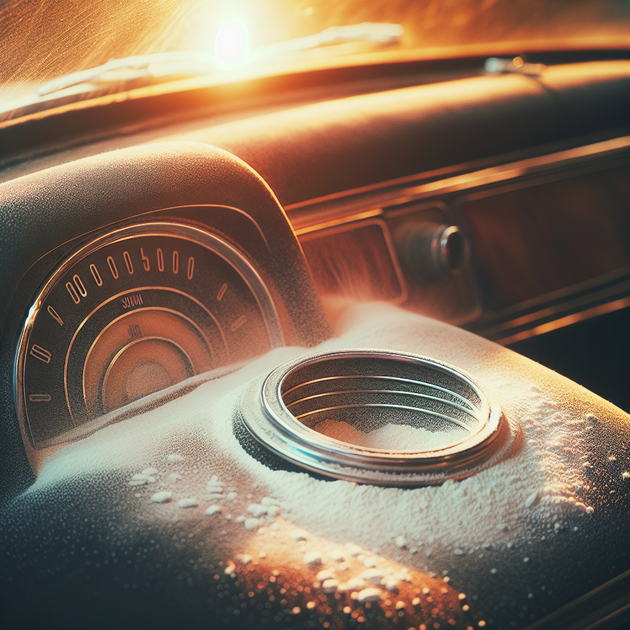Ever cleaned your dashboard spotless, only to find a strange, sugar-like dust show up again just days later? It’s a surprisingly common problem, especially in vintage cars like the 1976 Mercedes 240D. This fine, gritty dust seems to appear out of nowhere—even if you haven’t driven your car. So, what’s going on here?
Let’s break down the mystery behind this recurring dashboard dust, what might be causing it, and the best ways to tackle it for good.
Why Does Sugar-Like Dust Appear on Dashboards?
No, it’s not your imagination—and you’re definitely not the only one facing this. Many car owners, especially those with older models, notice a fine dust that looks just like sugar crystals forming on their dashboards. The reason isn’t always obvious, but there are a few likely suspects.
– **Aging Interior Materials:** In vintage cars like the Mercedes 240D, plastics, vinyl, and adhesives used in the dashboard can slowly degrade over time. As they break down, they can release tiny particles that settle like dust.
– **Environmental Factors:** Even if your car sits unused, changes in temperature and humidity can cause surfaces to expand, contract, and shed microscopic debris.
– **Air Vents and HVAC System:** Your car’s ventilation system can harbor dust, pollen, or even mold spores. When air moves—sometimes just from a breeze or opening a door—these particles can be pushed out and land on the dashboard.
– **External Pollutants:** Parking near trees or in dusty areas can introduce fine particulates through tiny leaks in door seals or vents.
According to Cars.com, interior dust often comes from both inside and outside sources. With older cars, the balance tends to tip toward materials inside the cabin breaking down.
Common Causes of Persistent Dashboard Dust
Let’s dig a little deeper into the most common causes of this sugar-like dust:
- Degrading Dashboard Material: As dashboards age, UV rays and heat can make them brittle. Tiny bits flake off over time.
- Old Foam Padding: Many classic cars have foam beneath the dashboard or in the HVAC system. This foam can disintegrate into fine particles.
- Loose Weatherstripping: Worn-out seals around doors and windows let in dust from outside, especially if you park under trees or near construction.
- Mold or Mildew Growth: Sometimes what looks like “dust” is actually a byproduct of mold or mildew if there’s been moisture inside your vehicle.
- HVAC System Issues: Air filters that haven’t been changed can blow dust directly onto your dashboard every time there’s airflow.
How to Stop Sugar-Like Dust from Returning
Now for the good news—there are steps you can take to minimize or even eliminate this mysterious dashboard dust.
- Deep Clean the Dashboard: Use a microfiber cloth and a gentle, non-abrasive cleaner designed for car interiors. Avoid harsh chemicals that might speed up material breakdown.
- Check and Replace Air Filters: Replace your cabin air filter regularly. If your classic car doesn’t have one, consider an upgrade if possible.
- Inspect Seals and Weatherstripping: Look for cracks or gaps in the rubber around doors and windows. Replacing worn seals keeps outside dust out.
- Condition the Dashboard: Products with UV protection help prevent further breakdown of vinyl and plastics. Check out AutoBlog’s dashboard cleaner recommendations for safe options.
- Control Moisture: If moisture is a problem, use silica gel packs or a small dehumidifier for cars to keep the interior dry.
- Regular Maintenance: A quick wipe-down every few days and routine checks of your car’s interior can go a long way.
Anecdote: When a Classic Car Owner Got Answers
A friend of mine once bought a vintage coupe and was baffled by the constant return of a gritty, sugar-like film on the dashboard. After months of cleaning, he finally discovered the culprit—a disintegrating foam pad inside his dash vents. Once he had it replaced by a professional, the dust problem vanished almost overnight. Sometimes, it really is something hidden just out of sight.
When to Get Professional Help
If you’ve tried all the suggestions above and that pesky dust still won’t quit, it might be time for a pro. Some issues—like deep-seated mold or major material breakdown—need specialized attention. An experienced mechanic or detailer familiar with classic cars can inspect your vehicle for hidden sources of dust.
For more insight into what causes persistent dust in vehicles, Family Handyman has some helpful tips on keeping your car interior dust-free.
Final Thoughts: Is Your Dashboard Trying to Tell You Something?
Sugar-like dust showing up over and over might seem harmless, but it’s often a sign your car’s interior needs attention—especially if it’s a classic like the Mercedes 240D. Keeping up with basic cleaning and maintenance is usually enough, but sometimes you’ll need to dig a little deeper.
Ever found a strange substance in your car that just wouldn’t go away? What did you do to solve it?

Leave a Reply